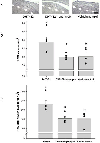Rapamycin blocks the neuroprotective effects of sex steroids in the adult birdsong system
- PMID: 31509642
- PMCID: PMC6823113
- DOI: 10.1002/dneu.22719
Rapamycin blocks the neuroprotective effects of sex steroids in the adult birdsong system
Abstract
In adult songbirds, the telencephalic song nucleus HVC and its efferent target RA undergo pronounced seasonal changes in morphology. In breeding birds, there are increases in HVC volume and total neuron number, and RA neuronal soma area compared to nonbreeding birds. At the end of breeding, HVC neurons die through caspase-dependent apoptosis and thus, RA neuron size decreases. Changes in HVC and RA are driven by seasonal changes in circulating testosterone (T) levels. Infusing T, or its metabolites 5α-dihydrotestosterone (DHT) and 17 β-estradiol (E2), intracerebrally into HVC (but not RA) protects HVC neurons from death, and RA neuron size, in nonbreeding birds. The phosphoinositide 3-kinase (PI3K)-Akt (a serine/threonine kinase)-mechanistic target of rapamycin (mTOR) signaling pathway is a point of convergence for neuroprotective effects of sex steroids and other trophic factors. We asked if mTOR activation is necessary for the protective effect of hormones in HVC and RA of adult male Gambel's white-crowned sparrows (Zonotrichia leucophrys gambelii). We transferred sparrows from breeding to nonbreeding hormonal and photoperiod conditions to induce regression of HVC neurons by cell death and decrease of RA neuron size. We infused either DHT + E2, DHT + E2 plus the mTOR inhibitor rapamycin, or vehicle alone in HVC. Infusion of DHT + E2 protected both HVC and RA neurons. Coinfusion of rapamycin with DHT + E2, however, blocked the protective effect of hormones on HVC volume and neuron number, and RA neuron size. These results suggest that activation of mTOR is an essential downstream step in the neuroprotective cascade initiated by sex steroid hormones in the forebrain.
Keywords: birdsong; estrogen; hormone; mechanistic target of rapamycin; neuroprotection; neurotrophins; protein phosphorylation; rapamycin; signaling pathway; songbird; testosterone; trophic factors; trophic support.
© 2019 Wiley Periodicals, Inc.
Figures




Similar articles
-
Adult Neurogenesis Leads to the Functional Reconstruction of a Telencephalic Neural Circuit.J Neurosci. 2016 Aug 24;36(34):8947-56. doi: 10.1523/JNEUROSCI.0553-16.2016. J Neurosci. 2016. PMID: 27559175 Free PMC article.
-
Brain-Derived Neurotrophic Factor Has a Transsynaptic Trophic Effect on Neural Activity in an Adult Forebrain Circuit.J Neurosci. 2020 Feb 5;40(6):1226-1231. doi: 10.1523/JNEUROSCI.2375-19.2019. Epub 2019 Dec 19. J Neurosci. 2020. PMID: 31857358 Free PMC article.
-
Neuroprotective effects of testosterone in a naturally occurring model of neurodegeneration in the adult avian song control system.J Comp Neurol. 2010 Dec 1;518(23):4760-70. doi: 10.1002/cne.22486. J Comp Neurol. 2010. PMID: 20963827 Free PMC article.
-
Seasonal-like growth and regression of the avian song control system: neural and behavioral plasticity in adult male Gambel's white-crowned sparrows.Gen Comp Endocrinol. 2008 Jul;157(3):259-65. doi: 10.1016/j.ygcen.2008.03.014. Epub 2008 Mar 25. Gen Comp Endocrinol. 2008. PMID: 18457836 Free PMC article. Review.
-
Transsynaptic trophic effects of steroid hormones in an avian model of adult brain plasticity.Front Neuroendocrinol. 2015 Apr;37:119-28. doi: 10.1016/j.yfrne.2014.09.003. Epub 2014 Oct 5. Front Neuroendocrinol. 2015. PMID: 25285401 Free PMC article. Review.
Cited by
-
New Perspectives on Avian Models for Studies of Basic Aging Processes.Biomedicines. 2021 Jun 7;9(6):649. doi: 10.3390/biomedicines9060649. Biomedicines. 2021. PMID: 34200297 Free PMC article. Review.
-
Adult neurogenesis is necessary for functional regeneration of a forebrain neural circuit.Proc Natl Acad Sci U S A. 2024 Jul 9;121(28):e2400596121. doi: 10.1073/pnas.2400596121. Epub 2024 Jul 5. Proc Natl Acad Sci U S A. 2024. PMID: 38968119 Free PMC article.
References
-
- Bolster DR, Crozier SJ, Kimball SR, & Jefferson LS (2002). AMP-activated Protein Kinase Suppresses Protein Synthesis in Rat Skeletal Muscle through Down-regulated Mammalian Target of Rapamycin (mTOR) Signaling. Journal of Biological Chemistry, 277(27), 23977–23980. doi:10.1074/jbc.C200171200 - DOI - PubMed
-
- Brenowitz EA (2008). Plasticity of the song control system in adult birds In Zeigler HP & Marler P (Eds.), Neuroscience of birdsong (pp. 332–349). Cambridge: Cambridge University Press.
Publication types
MeSH terms
Substances
Grants and funding
LinkOut - more resources
Full Text Sources
Miscellaneous

